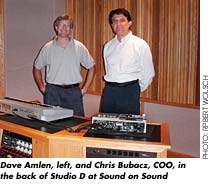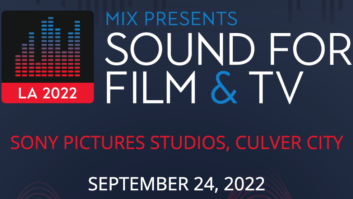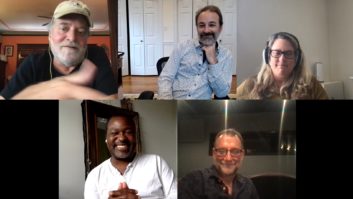
Even cornerstones of the New York City studio scene have to makeadjustments to their own foundations from time to time. The big tweak at Sound on Sound, on West 45th Street, is the addition of Studio D, a brand-new space built with the acoustics and care of an SSL room, but fully dedicated to a Digidesign Pro Tools | HD3 system.
The new room has joined Sound on Sound’s Studios A, B and C, outfitted with two SSL 9000 J consoles and a Sony Oxford, respectively, not necessarily because president Dave Amlen has a burning passion forPro Tools, but because he knows that many of his best customers do.“Everyone says, ‘What’s the secret to business?’” Amlen remarks. “The secret is listening to what your clients want: not giving them what you want, but what they want. If you can do that, it levels the playing field a lot more.”
For Sound on Sound, its full-blown Pro Tools environment —which they say marks the first time that a major studio has built a room from the ground up dedicated to maximizing Pro Tools | HD —is a proactive answer to some record companies’ belief that Pro Tools can be used by anyone, anywhere, at any budget to produce a quality disc. “These are real studios, not just offices that people threwPro Tools into,” states Amlen. “They’re designed and maintained by our staff. They have plug-ins, peripheral outboard gear, monitoring that’s accurate, client services — everything a client can think of. Yes, it will cost more than working in someone’s home, but we also didn’t have to shell out large amounts for a console and tape machines. There’s a cost savings, and that gets shared with our clients. The goal was to have a professional, acoustically designe denvironment where, to a client coming in, the difference between it and our primary rooms would strictly be the equipment. It’s a real room.”
Designed by Larry Swist of Lawrence P. Swist Designs (LPS), the inviting 19×18-foot control room, affixed to a 9×11-foot booth, houses a Pro Tools | HD3 system with four DSP process cards and features Pro Control with 24 faders and Editpack for surround panning and mixing. Video capture and an eye-grabbing 42-inch plasma screen make synching to picture convenient.
“One thing that gave us an advantage is that the big control surface [of a large-frame desk] gets in the way of the sound,”Amlen says. “In a Pro Tools room, you don’t have a huge console getting in the way of everything.”
The approach to monitoring was to provide complete consistency with the rest of the facility, as well as the most bang for the buck, usingYamaha NS-10s, Genelec 1031As and custom LPS Designs main monitors with subwoofers, loaded with TAD and JBL components. “We have NS-10sand Genelecs everywhere; we wanted that in Studio D so the client doesn’t have to relearn the sound of the monitors,” explainsAmlen. “The one thing we did here to appease the R&B crowd— because they need a lot of bottom — was Larry designed something that would work, instead of spending a lot on an Augspurger system. It has a lot of bottom, and it’s great for basic tracking, so in mixing, you don’t all of a sudden ask, ‘Where did this come from?’ Digital does not have the bass roll-off characteristics that analog tape has; if you don’t know what’s in your low-frequency range, you’ll be very surprised in mastering or, worse yet, in the consumer realm.”
The iso booth can comfortably fit a group of backup singers or a tag team of percussionists. It won’t really hold a drum set, however, which is perfectly fine with Amlen. “That’s not the purpose of it. If you want to record live drums, go into Studio A or B,” he says.“Each of our rooms has a purpose it excels in. Studio A is multipurpose, but it’s optimized for larger tracking and mixing. StudioB is optimized for smaller tracking and mixing, and Studio C is optimized for mixing and surround. So Studio D filters into the main rooms. They do all this Pro Tools work but realize there are limitations, and when they see that there’s an SSL room, it trickles down to some degree. That’s been a benefit. Unfortunately, there’s nota lot of artists with big budgets who can spend $2,500 a day, so you do what you’ve gotta do. This Pro Tools room is less than $1,000 a day.”
It’s all part of a business plan that Sound on Sound has studied and implemented since it opened. “Studio D will never compete with our main rooms; the idea was to supplement them,” Amlen says.“You don’t want to cannibalize your own business, so you ask,‘What’s the hole?’ The hole is people would come in and need high-end monitoring and outboard gear for mixing and live tracking, but for overdubs, they needed something more intimate. Now we have a soup-to-nuts equation.”
David Weiss is Mix’s New York editor.







